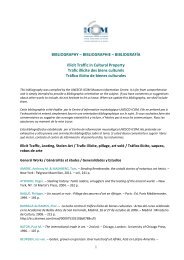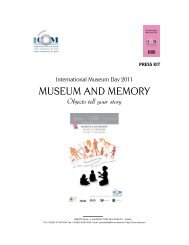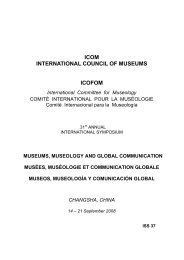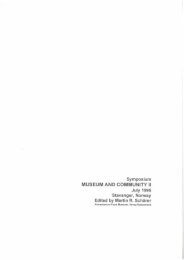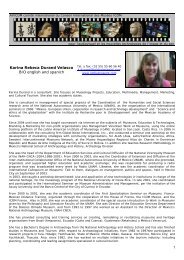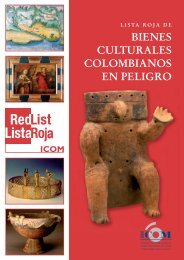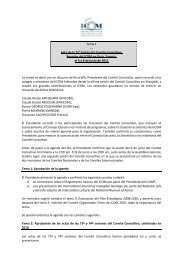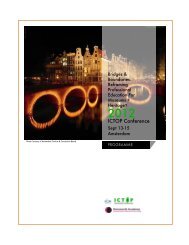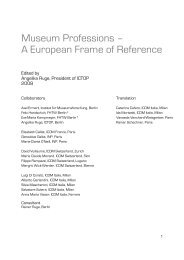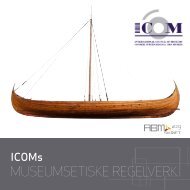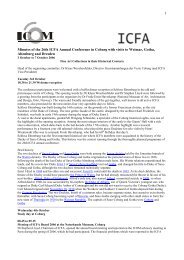Key Concepts of Museology - ICOM
Key Concepts of Museology - ICOM
Key Concepts of Museology - ICOM
You also want an ePaper? Increase the reach of your titles
YUMPU automatically turns print PDFs into web optimized ePapers that Google loves.
something, as well as the whole <strong>of</strong><br />
that which is displayed, and the place<br />
where it is displayed. “Let us consider<br />
a defi nition <strong>of</strong> the exhibition<br />
borrowed from outside and not drafted<br />
by ourselves. This term – along<br />
with its abbreviated term ‘exhibit’ –<br />
means the act <strong>of</strong> displaying things to<br />
the public, the objects displayed (the<br />
exhibits), and the area where this display<br />
takes place” (Davallon, 1986).<br />
Borrowed from the Latin expositio,<br />
the French term exposition (in old<br />
French exposicïun, at the beginning<br />
<strong>of</strong> the 12 th century) fi rst had at the<br />
same time the fi gurative meaning <strong>of</strong><br />
an explanation, an exposé, the literal<br />
meaning <strong>of</strong> an exposition (<strong>of</strong> an<br />
abandoned child, still used in Spanish<br />
in the term expósito), and the<br />
general meaning <strong>of</strong> display. From<br />
there (in the 16 th century) the French<br />
word exposition had the meaning<br />
<strong>of</strong> presenting (merchandise), then<br />
(in the 17 th century) it could mean<br />
abandonment, initial presentation<br />
(to explain a work) or situation (<strong>of</strong><br />
a building). In 18 th century France<br />
the word exhibition, as a display <strong>of</strong><br />
art works, had the same meaning in<br />
French as in English, but the French<br />
use <strong>of</strong> the word exhibition to refer to<br />
the presentation <strong>of</strong> art later gave way<br />
to exposition. On the other hand, the<br />
word exposition in English means<br />
(1) the setting forth <strong>of</strong> a meaning or<br />
intent, or (2) a trade show, thus preserving<br />
the earlier meanings <strong>of</strong> the<br />
French. Today both the French exposition<br />
and the English exhibition have<br />
the same meaning, which applies to<br />
the setting out <strong>of</strong> exhibits <strong>of</strong> all kinds<br />
in a space for public viewing; also the<br />
exhibits themselves, and the space in<br />
which the show takes place. From<br />
this viewpoint, each <strong>of</strong> these meanings<br />
defi nes somewhat different<br />
elements.<br />
1. The exhibition, understood as<br />
the container or the place where the<br />
contents are on display (just as the<br />
museum appears both as a function<br />
and as a building) is characterised<br />
not by the architecture <strong>of</strong> this space<br />
but by the place itself. Even though<br />
the exhibition appears to be one <strong>of</strong><br />
the characteristics <strong>of</strong> museums, exhibition<br />
thus has a far broader reach<br />
because it can also be set up by a<br />
pr<strong>of</strong>i t-making organisation (market,<br />
store, art gallery). It can be organised<br />
in an enclosed space, but also in the<br />
open air (in a park or a street) or in<br />
situ, that is to say without moving the<br />
objects from their original sites natural,<br />
historical or archaeological sites.<br />
Seen from this perspective exhibition<br />
areas are defi ned not only by the<br />
container and the contents but also<br />
by the users – visitors and museum<br />
pr<strong>of</strong>essionals – that is to say the people<br />
who enter this specifi c area and<br />
share in the general experience <strong>of</strong> the<br />
other visitors at the exhibition. The<br />
place <strong>of</strong> the exhibition is thus a specifi<br />
c place <strong>of</strong> social interaction, the<br />
effects <strong>of</strong> which can be assessed. Evidence<br />
<strong>of</strong> this is provided by the development<br />
<strong>of</strong> visitor studies, and the<br />
growth <strong>of</strong> a specifi c fi eld <strong>of</strong> research<br />
connected with the communication<br />
aspect <strong>of</strong> the place and with all the<br />
35



